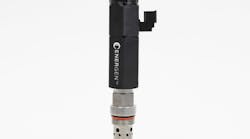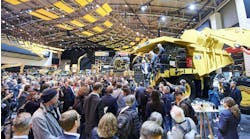In September 2022, Helios Technologies Inc. announced the launch of the ENERGEN cartridge valve from its Sun Hydraulics brand. The ENERGEN™ valve is designed to convert hydraulic flow into electric energy.
Development of the ENERGEN™ valve came from the company evaluating how its core business, cartridge valve technology, can meet the future state of the hydraulics industry said Steven Meislahn, Global Director of Engineering, Sun Hydraulics, in an interview with Power & Motion. “The opportunity was solidified when evaluating the intersection of electrification, battery-electric vehicles, and a drawback of hydraulics which is energy loss associated with pressure drop,” he said.
The rise in electrification and a desire for more energy efficient solutions is bringing new design opportunities to the hydraulics market and will be a focus for Sun Hydraulics going forward. The company recently launched its ecoline program – a line of products designed to help improve energy efficiency, reduce fuel consumption, and provide customers with overall cost savings. ENERGEN™ will be a part of this new product line.
In the following Q&A with Meislahn, he explains how the new ENERGEN™ valve technology works as well as potential applications and opportunities within the field of electrification.
*Editor’s note: Questions and responses have been edited for clarity.
Power & Motion (PM): Can you provide an overview of how the valve works, and how it converts hydraulic flow into electric energy?
Steven Meislahn (SM): The first application of ENERGEN™ has the functionality of a check valve which is designed to allow hydraulic flow in a certain direction within a hydraulic circuit. When the poppet comes off the seat allowing flow, hydraulic fluid passes through the valve across a turbine. The turbine is connected to a generator, which converts the mechanical flow into electrical energy.
PM: What is the benefit of being able to convert hydraulic flow to electric energy?
SM: Sun has been in discussions with potential customers looking at ENERGEN™ for three different applications. First, there are applications where hydraulic power is sufficient, but electrical energy is not. An example of this is attachments at the rear of a tractor. A new attachment may require electrical power that can exceed what’s available on an older tractor.
Second are applications where the designer cannot or does not want to run a wiring harness. Sometimes regulatory restrictions do not permit this, such as maintaining electrical isolation in an aerial work platform that works on electrical power lines. Another example is demolition machines that would require extensive guarding of the harness to protect it.
Last, machines can utilize ENERGEN™ to recoup energy that would otherwise be wasted. This feature would allow for regenerative energy into battery operated equipment by converting lost backpressure of a hydraulic system through the simple act of gravity lowering.
PM: Are there other benefits this new valve technology provides?
SM: An interesting opportunity ENERGEN™ creates is to have isolated electrical circuits. With its own power source, ENERGEN™ could be paired with sensors and a controller such as Sun’s XMD to be a self-powered, closed loop valve controller that does not need to be connected to a machine’s main power source, it [would] just need hydraulic flow.
PM: In which types of applications can this technology be utilized?
SM: Sun is developing ENERGEN™ to be used in applications up to 5,000 psi of pressure. The initial ENERGEN™ will have the ability to generate 250W of peak power at a flow rate of approximately 30 GPM. It is envisioned that ENERGEN™ will evolve into a family of products that can meet a wide range of applications by mixing and matching turbines and generators.
PM: How is your company seeing the trend toward electrification progressing, and what impacts are you seeing on hydraulic systems and components?
SM: Electrification is large part of Sun’s new product development, and it’s progressively [more] rare for a product to be developed that is purely hydromechanical.
PM: What opportunities, and challenges, are you seeing from electrification?
SM: There are countless opportunities to use electrification to improve control, efficiency, and ease of use. Electrification is also opening the doors to digitization, which will only allow the trends to continue by leveraging technologies such as machine learning and artificial intelligence.
A challenge is that product lifecycles in electrical products is much different than hydraulic products. The technology changes quickly, and where a hydromechanical product may not change for 20 years, an electrical product is nearing obsolescence after about 5 years.
PM: How does this new ENERGEN™ technology fit in with evolving customer needs for electrification-related solutions?
SM: ENERGEN™ is a product that sits squarely at the intersection of hydraulics and electrification. As the need for electrical power in hydraulic systems grows, so will the importance of ENERGEN™.



